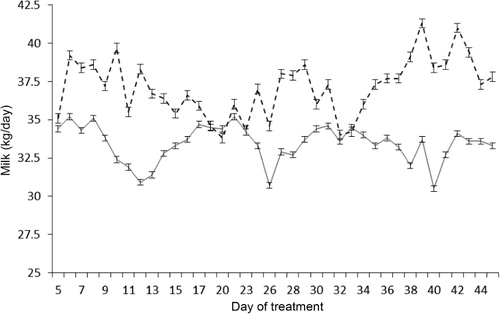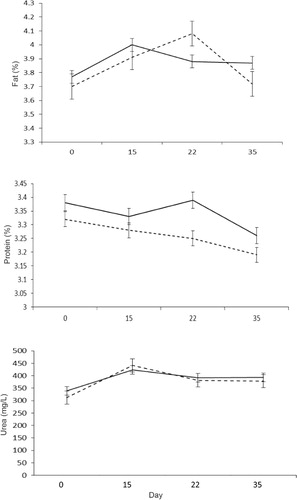Abstract
The objective was to analyze the effect of feeding dry molassed beet pulp (DMBP) on milk yield and milk composition in Holstein cows located in central Chile. Cows with similar days in milk, parity number, and management were randomly allocated in a control (n = 71) and a treatment (n = 74) group. The control group was fed the conventional diet of the farm, which is representative of diets commonly used in similar dairies in that geographic area. The treatment group received an isocaloric and isonitrogenous diet considering DMBP as a differential ingredient. Milk yield was recorded during a 45-day period and milk components were determined on day 0, 15, 22, and 35 of the study. The effect of the interaction between treatment and time on milk yield was highly significant with a difference of 3.4 kg/day in favor of the treatment group. No significant differences were detected for milk components between the two groups.
Keywords:
1. Introduction
Sugar beet pulp (SBP) is a by-product from the sugar refining industry. All Chilean domestic sugar production comes from sugar beet and about 150,000 tons of SBP are produced annually in the country for animal feeding. From these, 45,000 tons are produced as dry molassed beet pulp (DMBP; ODEPA Citation2012), which is a useful ruminant feed containing 12.5 MJ (2.986 Mcal) metabolisable energy and 79 g digestible crude protein per kilogram of dry matter (DM; Kelly Citation1983). This product is also rich in neutral detergent soluble fiber, mostly composed by pectins. As a result, DMBP may play a role of modulator of rumen fermentation avoiding the potential development of sub-acute rumen acidosis. Indeed, diets containing a high proportion of DMBP have a low depressive effect on roughage digestibility compared to high cereal rations, which limits potential problems due to acidosis (Kelly Citation1983; Kajikawa et al. Citation1990). In dairy cows the highly digestible neutral detergent soluble fiber has beneficial effects on milk yield and fat content. On the other hand, the high soluble nonfiber carbohydrate content in SBP products has a tendency to increase total DM intake.
Current studies evaluating the effect of feeding Holstein cows with SBP are limited and research about the use of this by-product under the specific conditions of high producing dairies in the central area of Chile is required. Consequently, the objective of this study was to evaluate the effect of feeding DMBP on milk yield and milk composition in Holstein cows located in central Chile.
2. Material and methods
2.1. Dairy farm
The study was conducted within a high-producing dairy farm located in central Chile (coordinates 33°20′S, 71°25′W) that consisted of 800 lactating Holstein cows, housed in a sand-bedded free-stall system. Cows were fed a single total mixed ration and milked three times daily. Rolling herd average milk yield was 36 kg/cow/day.
2.2. Study design
The study was conducted between June and December 2011. Cows with similar days in milk (~150 ± 3 days), the same parity number (parity 2), and equal management were randomly allocated in two groups. Group 1 was used as control (n = 71) and group 2 as treatment (n = 74). The control group was fed the conventional diet of the farm, which is representative of diets commonly used in similar dairies in that geographic area (). The treatment group received an isocaloric and isonitrogenous diet considering as differential ingredient the DMBP provided by a sugar refining company (IANSAGRO S.A., Santiago, Chile). The inclusion level of some of the other ingredients was adjusted to keep the nutrient value of the diets equivalent (). Samples of the total mixed ration of both control and experimental diet were obtained once a week and preserved until analysis. A composite sample was submitted to the Nutritional Laboratory of the University Santo Tomas, Chile for wet chemistry.
Table 1. Composition of experimental diets.
Both groups were kept under the same management during the whole experiment and the diets were offered as total mixed ration prepared in a commercial mixer (Supreme International, Alberta, Canada). Diet nutritional compositions are reported in .
Table 2. Nutrient and mineral composition of experimental diets.
Individual milk yields were recorded in every milking during a period of 45 days throughout a computerized milking system (S.A.E. Afikim, Israel). Composite milk samples (from the four quarters into a single sample vial) were collected for each cow during the morning milking on days 0, 15, 22, and 35 of the study. Milk samples were submitted to the laboratory of the Chilean Agricultural Research Center for fat, protein and urea determination. Unfortunately, lactose and total solid analyses were not available during this study.
2.3. Statistical analysis
Milk yields recorded on the Afifarm software (S.A.E. Afikim, Israel) were subsequently exported to an Excel spreadsheet. Milk fat, protein, and urea determinations were also stored in a spreadsheet. Milk yield was compared between groups starting 5 days after receiving the experimental diets, considering the first 5 days as an adaptation period. Milk yield and milk components were analyzed using the PROC MIXED (analysis of variance for repeated measures), developing a mixed model, with the cow considered as a random effect. The model also included days in milk, treatment, time, and the effect of interaction between treatment and time as the most important effect of the model. The covariance structure used in the analysis was selected based on the AIC and Bayesian criterion. The significance level was set at P ≤ 0.05. All the analyses were conducted on SAS (release 9.2; SAS Institute Inc., Cary, NC, USA).
3. Results and discussion
Least squares means for milk yield corrected by days in milk for the two treatment groups, across the whole study, are presented in . The effect of the interaction between treatment and time was highly significant (P < 0.01). The curves show evidence of a higher milk yield in favor of the group receiving molassed beet pulp, with a differential in milk yield of 3.4 kg/day. This is equivalent to an increment of 10% in production for cows fed DMBP compared with the cows not receiving the sugar by-product.

Least squares means for milk components (fat and protein) and urea nitrogen corrected by days in milk by treatment group across the whole study are presented in . Not significant effect was found for treatment on milk fat. In both groups milk protein decreased throughout the study without differences between the experimental diets (P > 0.05). No significant differences were found for milk urea nitrogen between groups during the time of the study (P > 0.05).

The differential ingredient in the experimental diet consisted of DMBP. The ingredients that were replaced in a greater magnitude by the inclusion DMBP were gluten feed, canola meal, and wet brewers. The effect of diet on milk yield over time was significant with an increment in the group receiving the experimental diet. This change could be partially explained by the composition of beet pulp with approximately 40% neutral detergent fiber and a high concentration of neutral-detergent soluble fiber, especially pectic substances (Voelker & Allen Citation2003a).
Ingredients high in starch usually increase ruminal production of volatile fatty acid and alter the proportions of individual volatile fatty acid produced (Voelker & Allen Citation2003c). Greater volatile fatty acid production can reduce ruminal pH, which inhibits fiber digestion and decreases microbial efficiency because of decreased microbial growth (Russell & Wilson Citation1996). Therefore, diluting starch with a nonforage carbohydrate source (such as DMBP) that is less rapidly fermented avoids a severe reduction in ruminal pH (Voelker & Allen Citation2003b, Citation2003c).
Contrary to our results, previous studies reported no effects of the substitution of dried beet pulp for corn grain on milk yield (Kajikawa et al. Citation1990; Mansfield et al. Citation1994; Swain & Armentano Citation1994; Clark & Armentano Citation1997). These findings were remarkable because diets based on only corn grain and low fiber were expected to produce more milk. However, despite a relatively low percentage of nonstructural carbohydrates, beet pulp consistently supported equivalent fat corrected milk yields when substituted for corn. The fibrous components of beet pulp are highly degradable in the rumen because they are low in lignin and high in pectin, which may account for the relatively high digestible energy value of beet pulp (Clark & Armentano Citation1997). Other study reported decreased milk yield when beet pulp was substituted for corn grain, but similar milk yield when beet pulp was substituted for wheat. Authors explained these finding because the diet based on corn grain contained 36% of starch while the diet based on beet pulp contained only 2.1% of starch which may partially explain the differences in milk production between groups (O’Mara et al. Citation1997).
Voelker and Allen (2Citation003a) reported that substituting beet pulp for corn caused a quadratic response in milk fat yield, with the highest yield for the intermediate level (6% beet pulp treatment). Mahjoubi et al. (Citation2009) reported an increase in milk fat after inclusion of beet pulp in late lactation cows. Our results indicated a trend for higher milk fat in the treatment group compared to the control at week 3 of the study (P = 0.11). No differences in milk protein were detected between the experimental diets, which is in agreement with data reported previously (Kajikawa et al. Citation1990; Mahjoubi et al. Citation2009).
4. Conclusion
Feeding DMBP to Holstein cows during middle lactation had a positive effect in milk yield with an increase of 10% (3.4 kg of milk) compared to the control group. Feeding DMBP had no effect on milk fat, milk protein, and milk urea content.
Acknowledgments
The authors appreciate the assistance of Mr. Paul Losch in reviewing the manuscript grammar.
References
- Clark PW, Armentano LE. 1997. Influence of particle size on the effectiveness of beet pulp fiber. J Dairy Sci. 80:898–904.
- Kajikawa H, Odai M, Saitoh M, Takahashi T, Tano R, Abe H, Abe A. 1990. Effects of sugar-beet pulp on ruminal and lactation performances of cows having different rumen fermentation patterns. Anim Feed Sci Technol. 31:91–104. 10.1016/0377-8401(90)90116-P
- Kelly P. 1983. Sugar beet pulp – a review. Anim Feed Sci Technol. 8:1–18. 10.1016/0377-8401(83)90038-X
- Mahjoubi E, Amanlou H, Zahmatkesh D, Ghelich Khan M, Aghaziarati N. 2009. Use of beet pulp as a replacement for barley grain to manage body condition score in over-conditioned late lactation cows. Anim Feed Sci Technol. 153:60–67. 10.1016/j.anifeedsci.2009.06.009
- Mansfield HR, Stern MD, Otterby EE. 1994. Effects of beet pulp and animal by-products on milk yield and in vitro fermentation by rumen microorganisms. J Dairy Sci. 77:205–216. 10.3168/jds.S0022-0302(94)76943-5
- ODEPA. 2012. Estadísticas Productivas, Chile; [cited 2012 Nov 13]. Available from: http://www.odepa.gob.cl/
- O’Mara FP, Murphy JJ, Rath M. 1997. The effect of replacing dietary beet pulp with wheat treated with sodium hydroxide, ground wheat, or ground corn in lactating cows. J Dairy Sci. 80:530–540.
- Russell JB, Wilson DB. 1996. Why are ruminal celluloytic bacteria unable to digest cellulose at low pH? J Dairy Sci. 79: 1503–1509. 10.3168/jds.S0022-0302(96)76510-4
- Swain SM, Armentano LE. 1994. Quantitative evaluation of fiber from nonforage sources used to replace alfalfa silage. J Dairy Sci. 77:2318–2331.
- Voelker JA, Allen MS. 2003a. Pelleted beet pulp substituted for high-moisture corn: 1. Effects on feed intake, chewing behavior, and milk production of lactating dairy cows. J Dairy Sci. 86:3542–3552. 10.3168/jds.S0022-0302(03)73959-9
- Voelker JA, Allen MS. 2003b. Pelleted beet pulp substituted for high-moisture corn: 2. Effects on digestion and ruminal digestion kinetics in lactating dairy cows. J Dairy Sci. 86:3553–3561. 10.3168/jds.S0022-0302(03)73960-5
- Voelker JA, Allen MS. 2003c. Pelleted beet pulp substituted for high-moisture corn: 3. Effects on ruminal fermentation, pH, and microbial protein efficiency in lactating dairy cows. J Dairy Sci. 86:3562–3570. 10.3168/jds.S0022-0302(97)76012-0
